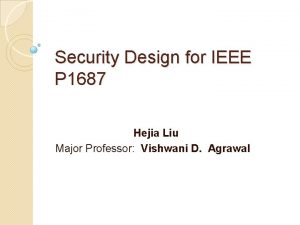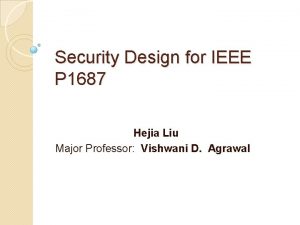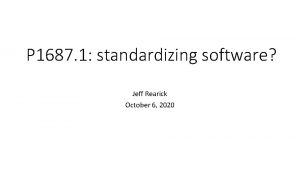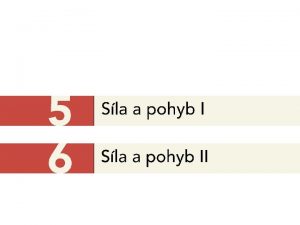Security Design for IEEE P 1687 Hejia Liu


























- Slides: 26

Security Design for IEEE P 1687 Hejia Liu Major Professor: Vishwani D. Agrawal

Introduction �Part 1: Introduction of IEEE P 1687 (IJTAG) security risks in P 1687 �Part 2: Security design and expected unlocking time �Part 3: Discussion of a proposal and improvement in security Apr 8, 2014 Liu: MEE Project 2

IEEE 1149. 1 (JTAG) Interface Apr 8, 2014 Liu: MEE Project 3

What is P 1687/ IJTAG? �IEEE P 1687 is a valuable tool for accessing on-chip instruments during test, diagnosis, debug and board configurations. �P 1687 is a proposed IEEE Standard that has 3 components ◦ A flexible set of serial scan chain techniques for the instrument access architecture (called the network) ◦ A network description language (called instrument connectivity language, ICL) ◦ An instrument vector language (called procedure description language, PDL) Apr 8, 2014 Liu: MEE Project 4

Communication between Chips An example of communication P 1687 network between 3 chips Apr 8, 2014 Liu: MEE Project 5

Instruments, IPs �An IP (Intellectual property core) with a P 1687 compliant interface is named instrument. �IPs: Analog, digital or mixed signal circuitry performing particular functions, such as a clock a generator, an interface to an external measurement probe, a radio tuner, an analog signal converter, a digital signal processor, etc. Apr 8, 2014 Liu: MEE Project 6

P 1687 Network Rst Optional Apr 8, 2014 Liu: MEE Project 7

FSM of TAP Controller Apr 8, 2014 Liu: MEE Project 8

Security Risks �Depending on the application, data may be stored on-chip, including chip ID, codes, and encryption keys. � An attacker can access a targeted instrument and obtain the secret data easily. Apr 8, 2014 Liu: MEE Project 9

A Possible Break-in Procedure �Step 1: Load Instruction code in TAP �Step 2: Shift in an attempt vector �Step 3: Clock the TAP controller �Step 4: If attempt successful, access instrument �Step 5: Else, repeat from step 2 Apr 8, 2014 Liu: MEE Project 10

Security Levels �Insecurity: Break-in time at the level of days �Weak security: Break-in time at the level of years �Strong security: Break-in time at the level of ten years �Full Security: Break-in time in the level of thousand years Apr 8, 2014 Liu: MEE Project 11

Structure of SIB (Segment Insertion Bit) Select=1 Shift. En=1 To_TDO 1 To_TDI 2 TDI From_TDO 2 0 0 1 1 0 1 Shift cell Update cell Select 1 Shift. En Select TCK Update. En Apr 8, 2014 Liu: MEE Project 12

Structure of SIB (Segment Insertion Bit) Select=0 Shift. En=1 To_TDO 1 To_TDI 2 TDI From_TDO 2 0 0 1 1 0 1 Shift cell Update cell Select 0 Shift. En Select TCK update. E n Apr 8, 2014 Liu: MEE Project 13

The Structure of SIB (Segment Insertion Bit) Shift. En=0 Update. En=1 To_TDI 2 To_TDO 1 0 TDI From_TDO 2 0 0 1 Shift cell 1 Update cell 1 1 1 Shift. En Select TCK Update. En Apr 8, 2014 Liu: MEE Project 14

Dworak, et al. . , ”Don’t forget to lock your SIB: Hiding instrument using P 1687, ” ITC 2013 Locking-SIB With Trap To_TDO 1 To_TDI 2 0 TDI From_TDO 1 1 0 1 Shift cell RST Update cell Shift. En Select TCK Update. En Key[0] Key[n ] Whether the key and trap feedback value is 1 or 0 is decided by structure Select Trap feedback select signal Apr 8, 2014 Liu: MEE Project 15

Unsecure and Secure P 1687 Networks Apr 8, 2014 Liu: MEE Project 16

Dworak, et al. , “Don’t forget to lock your SIB: Hiding instrument using P 1687, ” ITC 2013 Break-in Procedure Cost(LSIB unlock attempt w/Trap) Prob(opening SIB with key of k bits) Apr 8, 2014 Liu: MEE Project 17

Expected Results (f = 100 MHz) Expected time to unlock LSIB with Trap Days Years Key length K Chain Length N 8 16 32 48 640 1280 2560 5120 7. 79 E-07 3. 94 E-04 5. 13 E+01 6. 69 E+06 2. 13 E-09 1. 08 E-06 1. 41 E-01 1. 83 E+04 64 10240 8. 76 E+11 2. 40 E+09 80 20480 1. 15 E+17 3. 15 E+14 96 40960 1. 50 E+22 4. 11 E+19 Apr 8, 2014 Liu: MEE Project 19

Features of Secure Structure � Apr 8, 2014 Liu: MEE Project 20

An Original Proposal: Use SLFSR (Secure LFSR) to Hide Scan Path Length Apr 8, 2014 Liu: MEE Project 21

SLFSR Example Apr 8, 2014 Liu: MEE Project 22

Break-in Procedure Apr 8, 2014 Liu: MEE Project 23

Attacker’s Strategies � Apr 8, 2014 Liu: MEE Project 24

Expected Results (f = 100 MHz) Condition 3: � Key Chain length K N Expected time to unlock LSIB with SLFSR(days) Days Years cycles %Increase Compared to Trap without SLFSR 8 32 2. 32 E-07 6. 36 E-10 2. 01 e+05 395. 9596 16 64 9. 34 E-05 2. 56 E-07 8. 07 e+07 377. 9141 32 128 1. 06 E+01 2. 90 E-02 9. 14 E+12 365. 6357 40 160 3. 28 e+03 8. 98 2. 83 E+15 362. 8169 48 192 9. 85 E+05 2. 70 E+03 8. 51 E+17 360. 8592 56 224 2. 90 E+08 7. 93 e+05 2. 50 E+20 359. 4203 64 256 8. 37 E+10 2. 29 e+08 7. 23 E+22 358. 3181 80 320 6. 74 E+15 1. 85 E+13 5. 82 E+27 356. 7407 96 384 5. 24 E+20 1. 44 E+18 4. 53 E+32 355. 6663 Apr 8, 2014 Liu: MEE Project 25

Disadvantage Compared to Structure without SLFSR � Apr 8, 2014 Liu: MEE Project 26

Conclusion �It is useful we replace the non- functional segments with SLFSR �Security SLFSR increases attacker’s effort as breaking not only depends on the structure we build up, but also the strategies that attacker chooses. �We should be concerned about the “lucky” attacker Apr 8, 2014 Liu: MEE Project 27
 Ieee 1687
Ieee 1687 P 1687
P 1687 1687
1687 Alex liu cecilia liu
Alex liu cecilia liu Líu líu lo lo ta ca hát say sưa
Líu líu lo lo ta ca hát say sưa Private securty
Private securty Fspos
Fspos Novell typiska drag
Novell typiska drag Nationell inriktning för artificiell intelligens
Nationell inriktning för artificiell intelligens Returpilarna
Returpilarna Varför kallas perioden 1918-1939 för mellankrigstiden?
Varför kallas perioden 1918-1939 för mellankrigstiden? En lathund för arbete med kontinuitetshantering
En lathund för arbete med kontinuitetshantering Personalliggare bygg undantag
Personalliggare bygg undantag Vilotidsbok
Vilotidsbok Anatomi organ reproduksi
Anatomi organ reproduksi Vad är densitet
Vad är densitet Datorkunskap för nybörjare
Datorkunskap för nybörjare Stig kerman
Stig kerman Mall för debattartikel
Mall för debattartikel Magnetsjukhus
Magnetsjukhus Nyckelkompetenser för livslångt lärande
Nyckelkompetenser för livslångt lärande Påbyggnader för flakfordon
Påbyggnader för flakfordon Kraft per area
Kraft per area Offentlig förvaltning
Offentlig förvaltning Lyckans minut erik lindorm analys
Lyckans minut erik lindorm analys Presentera för publik crossboss
Presentera för publik crossboss Argument för teckenspråk som minoritetsspråk
Argument för teckenspråk som minoritetsspråk
















































